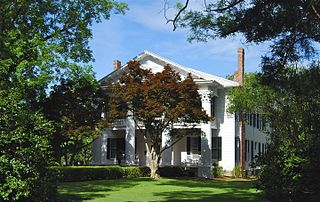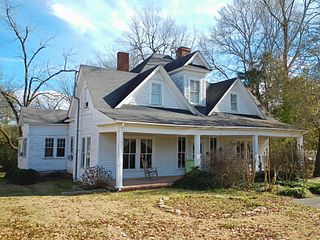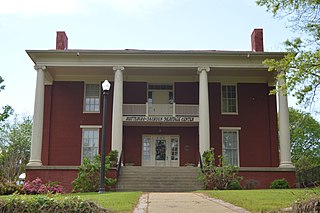
This is a list of sites in Minnesota which are included in the National Register of Historic Places. There are more than 1,700 properties and historic districts listed on the NRHP; each of Minnesota's 87 counties has at least 2 listings. Twenty-two sites are also National Historic Landmarks.

This is a list of more than 1,100 properties and districts in Nebraska that are on the National Register of Historic Places. Of these, 20 are National Historic Landmarks. There are listings in 90 of the state's 93 counties.

The Bessemer Hall of History is a museum located in, and devoted to the history of, the city of Bessemer, Alabama.

The Pine Apple Historic District is a historic district in the community of Pine Apple, Alabama. It was placed on the National Register of Historic Places on February 26, 1999. The boundaries are roughly Wilcox County roads 59, 7 and 61, Broad Street, Banana Street, AL 10, and Adams Drive. It contains 3,350 acres (1,360 ha), 54 buildings, and 1 structures ranging from the Craftsman to Colonial Revival styles.

The Magee Farm, also known as the Jacob Magee House, is a historic residence in Kushla, Alabama, United States. Built by Jacob Magee in 1848, the 1+1⁄2-story wood-frame structure is an example of the Gulf Coast Cottage style. The house is best known as the site of preliminary arrangements for the surrender of the last Confederate States Army east of the Mississippi River. Confederate General Richard Taylor negotiated a ceasefire with Union General Edward Canby at the house on April 29, 1865. Taylor's forces, comprising 47,000 Confederate troops serving in Alabama, Mississippi and Louisiana, were the last remaining Confederate force east of the Mississippi River. The Magee Farm was placed on the National Register of Historic Places on February 11, 1988. In 2004, partially through the efforts of the Civil War Trust, a division of the American Battlefield Trust, which helped save 12.6 acres of the farm, the house was opened as a museum. It ceased operation as a museum in 2010, due to a lack of public support and declining revenues, and was listed for sale. It was then listed on the Alabama Historical Commission's Places in Peril listing for 2010.

The Wilson–Finlay House also known as the Joshua Wilson House and the Finlay House, is a historic plantation house in Gainestown, Alabama. It was added to the Alabama Register of Landmarks and Heritage on September 17, 1976. It was placed on the National Register of Historic Places on July 12, 1978, due to its architectural significance.

The Hain-Harrelson House is a historic house in Sardis, Alabama, United States. The Classical Revival style structure was completed in 1913 for J. Bruce Hain on his working plantation. The house contains roughly 8,000 square feet (740 m2) spread over two floors. The interior is divided on a central hall plan. The front exterior is adorned with a monumental two-story Corinthian portico with a full-width second floor balcony. The house sat vacant for more than two decades until it was purchased by Cecil Gayle and Kenneth Parker of Atlanta in 1998. They stabilized and restored the home to its original condition. It was added to the National Register of Historic Places on November 30, 2001. The home was purchased in December 2015 by Ray and Angie Harrelson of Selma, AL.

The Gibbs House is a historic house in Gainesville, Sumter County, Alabama. The one-story wood-frame structure was built for Hawkins Gibbs from 1860 to 1861. The vernacular Greek Revival style house features a main central block with a side-gable roof, flanked by front-gabled wings to either side. The front facade of the main block features a full-width porch, set under the main roof. A similar version of this arrangement, largely unique to the Gainesville area in Alabama, is seen at Aduston Hall and a number of other nearby houses. It was added to the National Register of Historic Places on October 3, 1985.

The John Morgan House is a historic house in Heflin, Alabama. The house was built circa 1880 by John Francis and Louise Perryman Morgan, on land given to John for his service in the Mexican–American War. After Heflin was incorporated in 1892, Morgan was elected its first mayor.
The Parks E. Ball House is a historic house near Aliceville, Pickens County, Alabama. It is the only surviving Antebellum brick house in the county.

The Hugh Wilson Hill House, also known as the Kelly-Stone-Hill House, is a historic house in Carrollton, Pickens County, Alabama. It is one of only a few surviving antebellum structures remaining in the town. Architectural historians believe that the one-story Greek Revival-style house was built for Isham and Elizabeth Kelly during the late 1830s or 1840s. Confederate general John Herbert Kelly grew up in the house. It was added to the National Register of Historic Places on April 13, 1989. It was listed as one of Alabama's "Places in Peril" for 2010 by the Alabama Historical Commission and Alabama Trust for Historic Preservation.

The Withers-Chapman House is a historic residence in Huntsville, Alabama. The house was built by Allen Christian circa 1835 as the center of a farm that would become one of the major dairy suppliers in central North Alabama. After Christian's death in 1849, the house was purchased by Augustine and Mary Withers. Former Governor of Alabama Reuben Chapman acquired the house in 1873, after his previous house nearby had been burned by departing Union soldiers in 1865. The house remained in Chapman's family from 1873 until 1971. The surrounding farmland has been sold off into suburban development, but the house retains a prominent position on a 2-acre lot on a hillside.

The Steger–Nance House is a historic residence in Maysville, Alabama. It was built in 1854 by physician Francis Epps Harris Steger. Later owners included another physician, Issac William Howard, and local cotton gin owner and farmer Harry F. Nance. The house is built in a Federal style of brick laid in common bond. The house originally had a central hall flanked by a drawing room and parlor, with a dining room behind the parlor in an ell. A kitchen, bathroom, center hall, sitting room, and patio were added to the rear of the house in 1950. The house has three chimneys in each of the gable ends. Windows on the façade are nine-over-nine sashes flanked by narrow three-over-three sashes. A shed roofed porch stretches across the front, supported by six pairs of square columns on brick pillars. A narrow balcony, accessed from the upstairs hall, is centered above the front door. The house was listed on the Alabama Register of Landmarks and Heritage in 1981 and the National Register of Historic Places in 1982.

The Phelps–Jones House is a historic residence in Huntsville, Alabama. One of the oldest buildings in Alabama, it was built in 1818, shortly after the initial federal land sale in Madison County in 1809. Despite having many owners, the original character of the house has remained. The two-story house is built of brick laid in Flemish bond, and has Federal and Georgian details. The original block has a bedroom and parlor separated by a central hall, with a dining room in an ell to the northeast. Staircases in the hall and dining room led to three bedrooms on the second floor. In 1956, a porch in the crook of the ell was enclosed, adding a bathroom and small bedroom. Another porch off the rear of the dining room was enclosed and converted into a kitchen. Interior woodwork, including six mantels, is in provincial Federal style. The façade is five bays wide, with twelve-over-twelve sash windows on the ground floor and twelve-over-eight on the second. A narrow hipped roof porch covers the double front door; originally a wider porch covered a single door flanked by narrow sidelights and topped with a transom. The house was listed on the Alabama Register of Landmarks and Heritage in 1979 and the National Register of Historic Places in 1982.

The Jude–Crutcher House is a historic plantation house in Huntsville, Alabama. The house was built circa 1812 on land deeded that year to Samuel Echols. Echols sold 54 acres and the house to George Jude, Sr., in 1817. Jude died two years later, leaving the land to his son, George Jr. The younger Jude eventually acquired 800 acres and owned 31 slaves. Upon his death in 1873, the land stayed in the family until 1883. In 1906 David Crutcher, who had been born a slave on an adjacent plantation in 1851, purchased the house and 154 acres along with two other African-American men. The Crutchers operated a successful farm on their portion of the land, which was an extension farm for Alabama A&M University until the 1940s. Only 7% of African-American farmers in Madison County in 1910 owned their own farms. David died in 1924, and his wife, Lucy, died in 1943, although the house and land is still in the family.

The Brown–Proctor House is a historic residence in Scottsboro, Alabama. The house was built in 1881 by John A. Brown, who sold it just one year later. He sold the house to General Coffey, who bought the house for his daughter Sarah, for 3,200 dollars. John Franklin Proctor, a politician who served in the Alabama Legislature from 1892 through 1899 and was an attorney for the Scottsboro Boys in 1931, purchased the house in 1907. Proctor made numerous renovations to the house, including altering the two-story front portico with Tuscan columns into its current state of a single-level porch supported by Ionic columns with a central second floor balcony. A three-room addition was also built onto the back of the house, adding to the central hall plan of the original house. After his death in 1934, Proctor's family owned the house until 1981.

Old Indianapolis City Hall, formerly known as the Indiana State Museum, is a historic city hall located at Indianapolis, Indiana. It was built in 1909–1910, and is a four-story, Classical Revival style brick building sheathed in Indiana limestone. It measures 188 by 133 feet.

















